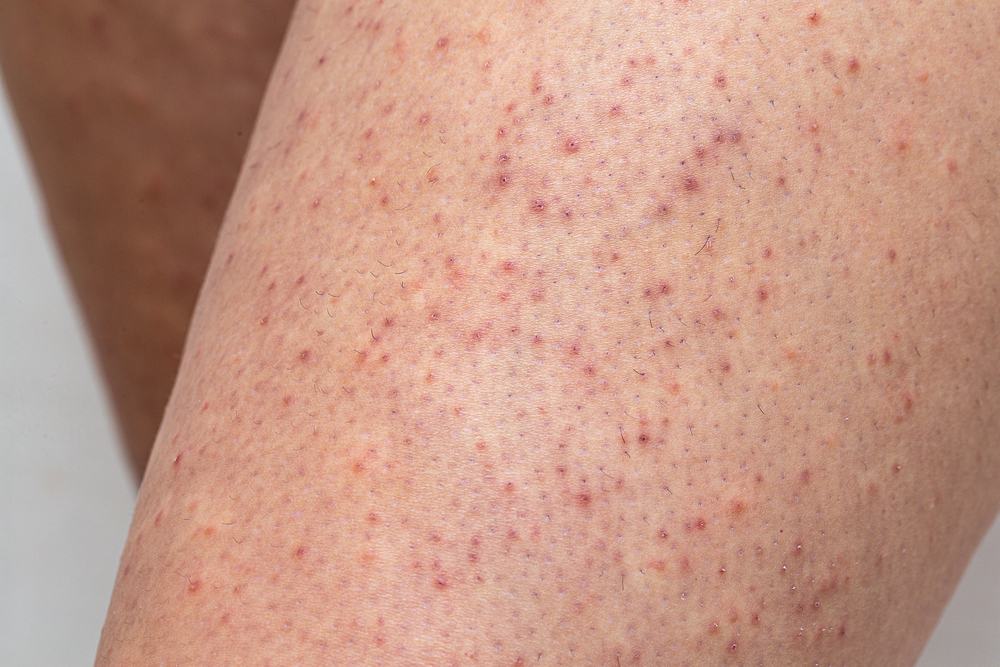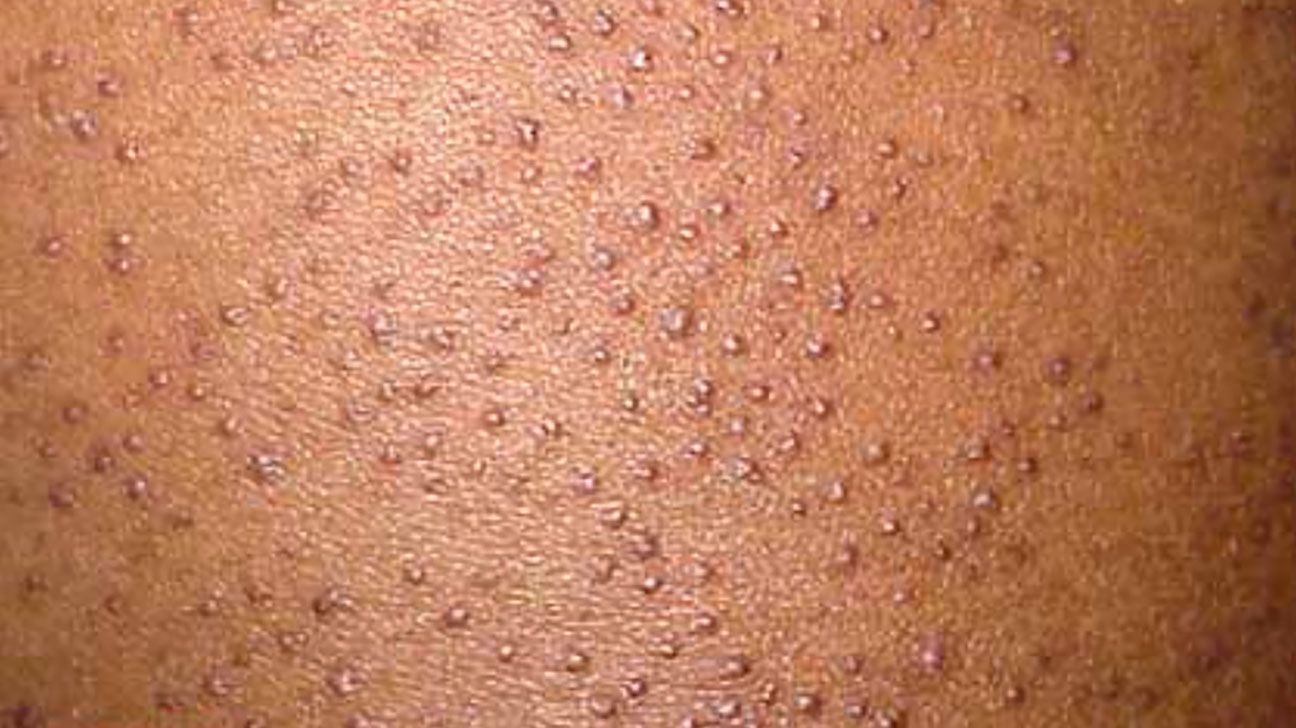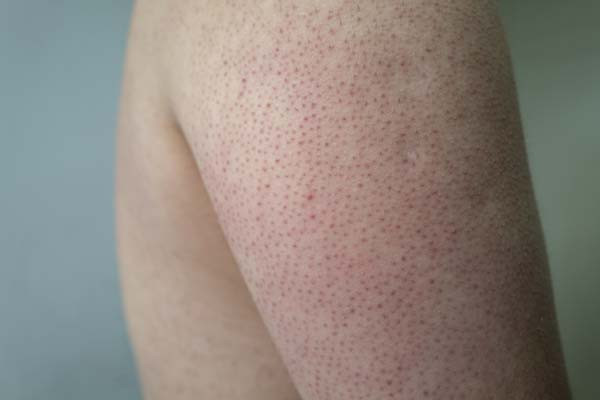To manage keratosis Pilaris Self-Care, regularly moisturize your skin and gently exfoliate to remove dead skin cells. Avoid harsh soaps and hot showers.
Keratosis Pilaris, often called “chicken skin,” affects many individuals, causing small, rough bumps on the skin. These bumps usually appear on the arms, thighs, cheeks, or buttocks. Consistent self-care routines can significantly improve the appearance and feel of your skin.
Moisturizing daily with a lotion containing urea or lactic acid helps soften the bumps. Gentle exfoliation using a soft brush or a mild scrub removes dead skin cells, preventing clogged hair follicles. Avoiding hot showers and harsh soaps reduces skin irritation and dryness. With these simple steps, you can effectively manage and reduce the symptoms of Keratosis Pilaris.
Introduction To Keratosis Pilaris
Keratosis Pilaris, often called KP, is a common skin condition. It causes small, rough bumps on the skin. These bumps usually appear on the arms, thighs, cheeks, and buttocks. Though harmless, KP can be frustrating. Understanding KP helps in managing it better.
What Is Keratosis Pilaris?
Keratosis Pilaris is a build-up of keratin. Keratin is a protein that protects the skin. When keratin clogs hair follicles, small bumps form. These bumps feel rough and look like goosebumps. KP is not contagious or dangerous. It often appears in childhood and may worsen during winter.
Common Myths Debunked
Many myths surround Keratosis Pilaris. Let’s address some of them:
- Myth: KP is caused by poor hygiene.
- Fact: KP is genetic and not related to cleanliness.
- Myth: KP goes away with age.
- Fact: KP can persist into adulthood.
- Myth: Scrubbing helps remove KP bumps.
- Fact: Over-scrubbing can irritate the skin and worsen KP.
Understanding these myths helps in better managing KP. Always consult a dermatologist for proper advice.

Credit: www.healthline.com
Identifying Keratosis Pilaris
Keratosis Pilaris, often called “chicken skin,” is a common skin condition. It appears as tiny, rough bumps on the skin. Many people mistake it for acne or dry skin. Knowing what to look for can help you identify it correctly.
Symptoms And Signs
The most noticeable symptom is small, rough bumps on the skin. These bumps are usually white or red. They often appear on the arms, thighs, cheeks, or buttocks. The skin may feel dry and rough to the touch. Sometimes, the area can become itchy or irritated.
- Rough Bumps: Tiny, sandpaper-like bumps on the skin.
- Color: Bumps are white, red, or skin-colored.
- Location: Commonly on arms, thighs, cheeks, and buttocks.
- Texture: Skin feels dry and rough.
- Itching: The area can be itchy or irritated.
When To See A Doctor
Keratosis Pilaris is usually harmless and doesn’t need medical treatment. But if the condition worsens, see a doctor. Here are some signs:
- Severe Itching: If the itching is intense and bothersome.
- Infection Signs: Redness, swelling, or pus in the bumps.
- Uncertainty: If you are unsure about the diagnosis.
| Sign | Action |
|---|---|
| Severe Itching | Consult a doctor |
| Infection Signs | Seek medical help |
| Uncertainty | Get a professional opinion |
Identifying Keratosis Pilaris early helps manage the condition better. Look for the symptoms and take action if needed.
Daily Skincare Routine
Keratosis Pilaris, often called “chicken skin,” is a common skin condition. Managing it requires a consistent daily skincare routine. Here’s a simple guide to help you keep your skin smooth and healthy.
Gentle Cleansing
Start your day with a gentle cleanser. Avoid harsh soaps that can dry out the skin. Look for products with moisturizing ingredients like glycerin or hyaluronic acid.
Follow these steps for effective cleansing:
- Use lukewarm water to wet your skin.
- Apply the cleanser using circular motions.
- Rinse thoroughly and pat dry with a soft towel.
Moisturizing Essentials
Moisturizing is crucial for managing Keratosis Pilaris. Use a thick moisturizer to keep your skin hydrated. Opt for products containing urea or lactic acid.
Here’s a simple moisturizing routine:
- Apply moisturizer immediately after showering.
- Focus on areas with bumps and dryness.
- Repeat application if your skin feels dry.
| Ingredients | Benefits |
|---|---|
| Urea | Hydrates and softens skin |
| Lactic Acid | Exfoliates and smooths skin texture |
Maintaining a daily skincare routine can help control Keratosis Pilaris. Be consistent and patient for the best results.
Exfoliation: Do’s And Don’ts
Exfoliation is a key step in managing Keratosis Pilaris. It helps remove dead skin cells and smooths rough patches. But, it’s important to know the right way to exfoliate. Doing it wrong can irritate your skin and worsen the condition. Here are some guidelines to help you out.
Choosing The Right Exfoliant
Picking the right exfoliant is crucial. There are two types: physical and chemical. Physical exfoliants include scrubs with tiny granules. Chemical exfoliants use acids to dissolve dead skin cells.
Physical Exfoliants:
- Look for gentle scrubs with fine particles.
- Avoid scrubs with large, rough granules.
- Choose scrubs with moisturizing ingredients like aloe vera.
Chemical Exfoliants:
- Opt for products with lactic acid or glycolic acid.
- Avoid high-concentration acid peels.
- Consider products with salicylic acid for acne-prone skin.
How Often To Exfoliate
Exfoliating too often can harm your skin. It can cause redness and irritation. Follow these guidelines to find the right balance.
For Physical Exfoliants:
- Exfoliate 2-3 times a week.
- Use gentle pressure to avoid damaging your skin.
For Chemical Exfoliants:
- Start with once a week.
- Gradually increase to 2-3 times a week if needed.
Always moisturize your skin after exfoliating. This helps lock in moisture and keep your skin soft.
Hydration And Nutrition
Hydration and nutrition play key roles in managing Keratosis Pilaris Self-Care. Proper care from inside can make a big difference. Here, we explore foods and hydration tips for better skin health.
Foods To Favor
Eating the right foods helps your skin stay smooth and healthy. Choose foods rich in vitamins and antioxidants.
- Vitamin A: Carrots, sweet potatoes, and spinach
- Omega-3 Fatty Acids: Salmon, flaxseeds, and walnuts
- Vitamin E: Almonds, sunflower seeds, and avocados
- Zinc: Pumpkin seeds, chickpeas, and lentils
Staying Hydrated For Skin Health
Staying hydrated is essential for skin health. Water helps keep your skin moist and supple. Aim to drink at least 8 glasses of water each day.
Here are a few tips to help you stay hydrated:
- Carry a water bottle with you.
- Eat water-rich foods like cucumbers and watermelons.
- Set reminders to drink water.
- Drink herbal teas and avoid sugary drinks.
Proper hydration and nutrition can greatly improve your skin’s appearance. Make these simple changes to your diet and hydration habits.
Lifestyle Modifications
Living with Keratosis Pilaris can be challenging, but lifestyle modifications can help. These changes can improve your skin’s appearance. They also help manage symptoms effectively. Let’s explore some key areas of focus:
Stress Management
Stress can worsen many skin conditions, including Keratosis Pilaris Self-Care. Managing stress can help keep symptoms under control. Here are some tips:
- Practice mindfulness: Spend time each day in meditation.
- Get adequate sleep: Aim for 7-8 hours each night.
- Engage in hobbies: Do activities that make you happy.
- Stay organized: Keep a planner to manage tasks.
Impact Of Exercise
Exercise benefits both your body and mind. Regular exercise can improve your skin’s health. Here are the key benefits:
| Benefit | Description |
|---|---|
| Improved Circulation | Exercise increases blood flow to the skin. |
| Stress Reduction | Physical activity releases endorphins, reducing stress. |
| Detoxification | Sweating helps remove toxins from the body. |
Engage in activities like:
- Walking or jogging
- Yoga or Pilates
- Cycling or swimming
Consistency is key. Aim for at least 30 minutes of exercise a day.
Over-the-counter Treatments
Keratosis Pilaris, often called “chicken skin,” can be annoying. Over-the-counter treatments offer simple ways to manage this skin condition. These treatments can smoothen the skin and reduce redness.
Recommended Products
Using the right products is crucial for managing Keratosis Pilaris. Here are some highly recommended options:
| Product | Description |
|---|---|
| AmLactin Daily Moisturizing Lotion | Contains lactic acid to exfoliate and hydrate the skin. |
| CeraVe SA Lotion | Includes salicylic acid for gentle exfoliation and ceramides for moisture. |
| Glytone Exfoliating Body Wash | Features glycolic acid to remove dead skin cells effectively. |
Ingredients To Look For
Knowing the right ingredients can make a big difference. Look for these key ingredients in over-the-counter treatments:
- Lactic Acid: Helps exfoliate and moisturize the skin.
- Salicylic Acid: Unclogs pores and reduces bumps.
- Glycolic Acid: Removes dead skin cells and smooths the skin.
- Urea: Softens and hydrates rough skin.
Using products with these ingredients can improve skin texture. Always patch test a new product to avoid irritation.

Credit: www.riverchasedermatology.com
Professional Treatments
Keratosis pilaris self-care can be stubborn. Sometimes, self-care routines aren’t enough. Professional treatments offer advanced solutions. They can help manage and reduce symptoms effectively. Here, we discuss when to consider professional help and the available options.
When To Consider
It may be time to seek professional help if:
- Home remedies aren’t working
- The condition affects your self-esteem
- Skin irritation becomes severe
- Symptoms worsen over time
Consult a dermatologist for expert advice. They can provide tailored treatments.
Available Options
Several professional treatments can help manage Keratosis Pilaris:
| Treatment | Description |
|---|---|
| Laser Therapy | Targets affected areas. Reduces redness and bumps. |
| Microdermabrasion | Exfoliates the skin. Improves texture and appearance. |
| Chemical Peels | Removes dead skin cells. Promotes new skin growth. |
| Topical Retinoids | Encourages cell turnover. Reduces blocked hair follicles. |
Each treatment has its benefits. Discuss with your dermatologist to choose the best option.
Preventing Flare-ups
Keratosis pilaris self-care can be bothersome, but you can manage it. Preventing flare-ups involves simple lifestyle changes. Focus on clothing, fabrics, and environmental factors. These small adjustments can make a big difference.
Clothing And Fabric Choices
The right clothing helps prevent flare-ups. Opt for soft, breathable fabrics like cotton. Avoid wearing rough or scratchy materials. These can irritate your skin. Wool and synthetic fabrics may cause more irritation.
Choose loose-fitting clothes. Tight clothes can rub against your skin. This friction can worsen Keratosis Pilaris. Here is a quick guide on fabric choices:
| Fabric | Effect on Skin |
|---|---|
| Cotton | Gentle and breathable |
| Wool | Can be rough and irritating |
| Synthetics | May cause irritation |
Environmental Factors
Environmental factors also play a role. Dry air can worsen Keratosis Pilaris. Use a humidifier to keep air moisture levels balanced. This helps your skin stay hydrated.
Temperature extremes are also a concern. Both hot and cold weather can trigger flare-ups. Try to maintain a moderate temperature in your home. Here are some tips:
- Use lukewarm water for showers.
- Avoid long, hot baths.
- Apply moisturizer right after washing.
These steps can help minimize Keratosis Pilaris flare-ups. Simple changes can make your skin feel better.

Credit: www.healthline.com
Frequently Asked Questions
How To Get Rid Of Keratosis Pilaris Fast?
To quickly reduce keratosis pilaris, exfoliate regularly and moisturize with creams containing lactic acid or urea. Use gentle cleansers.
What Worsens Keratosis Pilaris?
Dry skin, cold weather, and harsh skincare products can worsen keratosis pilaris. Avoid excessive scrubbing and hot showers.
What Is The Root Cause Of Keratosis Pilaris?
Keratosis pilaris is caused by a buildup of keratin, a protein that protects skin, blocking hair follicles. This results in rough, bumpy patches.
What Causes Keratosis Pilaris To Flare Up?
Dry skin, cold weather, hormonal changes, and friction from clothing can cause keratosis pilaris to flare up.
Conclusion
Achieving smoother skin with keratosis pilaris requires consistent self-care. Regular exfoliation and moisturizing can make a big difference. Consider consulting a dermatologist for personalized advice. Embrace a gentle skincare routine to manage symptoms effectively. With patience and care, you can improve your skin’s appearance and feel more confident.




Leave a Reply